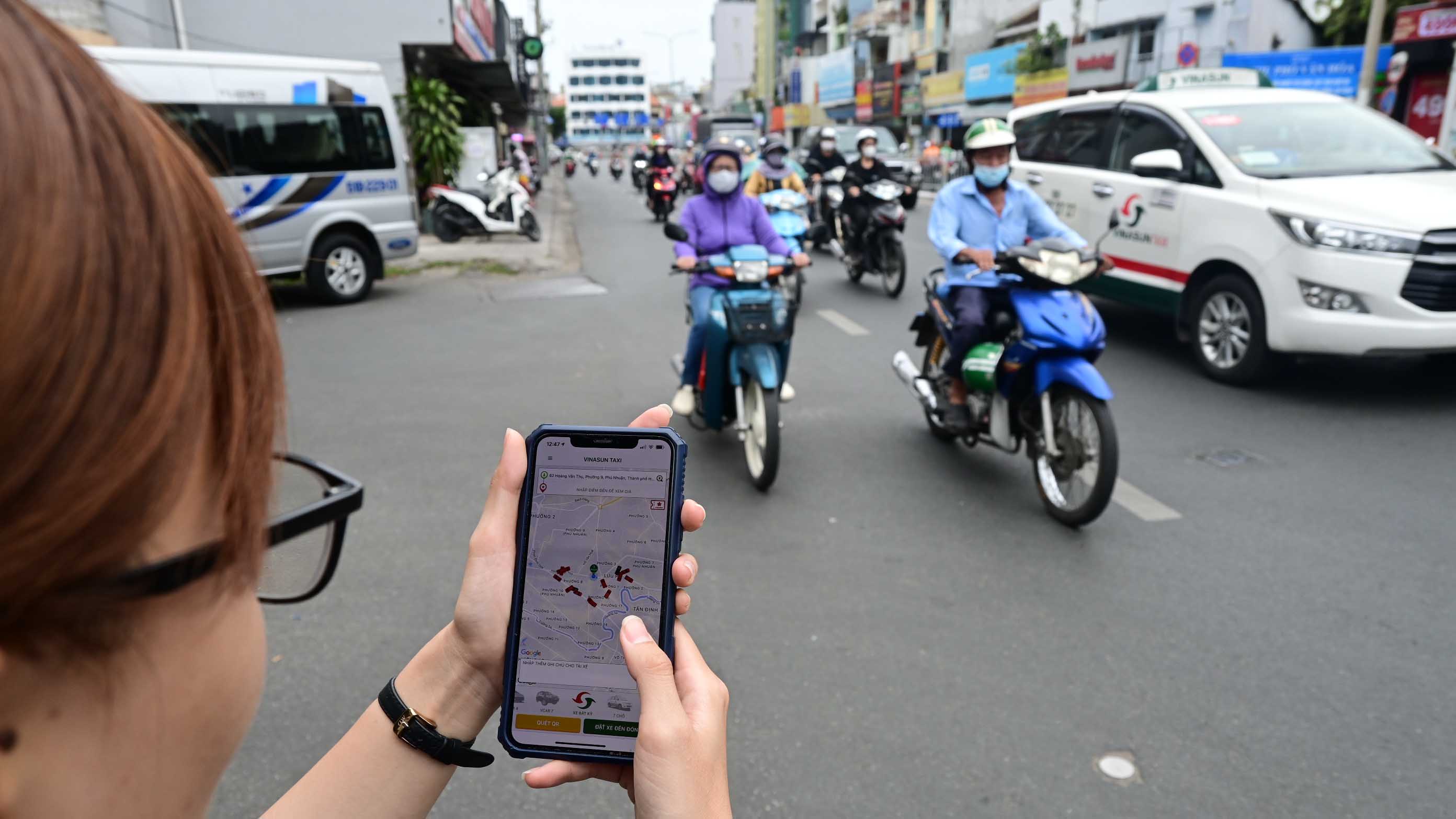After facing a fierce competition from wide-spread ride-hailing services for a long time, traditional taxi firms in Vietnam have returned to a race to win over drivers and passengers.
They have invested heavily on apps and stabilized transport fees which are 20-30 percent lower than those of ride-hailing service providers, thus attracting drivers and customers.
Shifting from ride-hailing to taxi services
After working for ride-hailing firms, many drivers have admitted that the golden age of ride-hailing apps has passed.
Khoa, residing in Go Vap District, Ho Chi Minh City, who had been an Uber and Grab driver since these apps were launched in Vietnam, abandoned these apps to drive a traditional taxi.
According to Khoa, between 2015 and 2017, ride-hailing drivers earned daily incomes of VND1.5-2 million (US$63-85) thanks to the high number of customers, low charges, and numerous promotion programs.
However, ride-hailing firms have repeatedly increased their commission rates, which have reached 32 percent on average, making life harder for drivers.
“Taxi and ride-hailing fees are equivalent, while taxi firms have apps, switchboards and reasonable commission rates,” Khoa said.
Taxi firms, such as Vinasun and Mai Linh, have shifted to the franchise model to reduce the operation pressure.
Vinasun requires a franchise fee of VND11 million ($468.8) per year and a deposit of VND12 million ($511.4). Drivers cooperating with Vinasun will be entitled to a commission rate of 15.5 percent of their revenue.
Besides their drivers, taxi firms have worked with partner-drivers like ride-hailing firms. Their service fees are stable and do not fluctuate much during rush hours.
All drivers are required to comply with the firm’s regulations and are supervised and regulated through a switchboard.
Nguyen Minh Trang, a resident in Binh Thanh District, Ho Chi Minh City, said taxi and ride-hailing service fees have not been significantly different recently.
Moreover, users of ride-hailing services are charged with multiple kinds of fees during peak and rainy hours, while taxi fares remain unchanged.
“As a result, passengers will prefer traditional taxis during rush hours,” Trang added.
 |
| A resident booked a taxi through an app in Phu Nhuan District, Ho Chi Minh City on January 5, 2023. Photo: Quang Dinh / Tuoi Tre |
Surging taxi app downloads
Since ride-hailing services Uber and Grab were present in Vietnam in 2015, local taxi firms have developed taxi-hailing apps.
However, the app development has encountered multiple difficulties, according to a taxi firm’s representative.
As for traditional taxis, passengers have got used to calling switchboards and catching taxis on roads and have yet to be acquainted with using taxi-hailing apps.
“[Taxi operators] have improved features of apps by upgrading their servers and payment methods over the years,” the taxi firm’s representative noted.
According to statistics from a taxi firm, an average of 10,000 services were successfully booked through its app per day, accounting for 30 percent of services booked by all of its customers.
The number of passengers downloading the app reached 180,000 as of September last year, triple the figure in 2021.
“Taxi and ride-hailing firms share a same market. When technologies develop, taxi firms must invest heavily in technologies to increase their competitiveness,” the representative said, adding that apps help regulate pick-ups appropriately and minimize idle vehicles.
Nevertheless, traditional taxi firms admitted that many obstacles remain, such as the shortage of app developing manpower, inaccurate positioning of passengers, poor navigation, and drivers’ failure to comply with rules.
According to Le Trung Tinh, chairman of the Ho Chi Minh City Intercity Passenger Transport and Tourism Association, in the initial period, ride-hailing firms have spent efforts to take care of their customers with many promotion programs, such as low fares, discounts, and free extra services.
However, once they earned market shares, they charged many fees and increased fares.
“It is easy to understand why many people have chosen traditional taxis. However, some drivers [of taxi companies] inactivate apps or quit the job without notice and cancel services, impeding the regulation of drivers,” Tinh said.
Ta Long Hy, chairman of the Ho Chi Minh City Taxi Association, said ride-hailing service fees have increased to near those of taxi operators.
“Ride-hailing firms are almost unable to offer promotions, such as free or low-cost services,” Hy said, adding that this is a reason why thousands of service bookings are made per day through taxi firms’ apps.
Taxi-hailing apps need improving
Many customers agreed that they download taxi-hailing apps but do not use them as frequent as ride-hailing apps, such as Grab, Be, and Gojek.
Minh Nguyet, an employee of a logistics company in District 1, Ho Chi Minh City, assessed that apps of traditional taxi firms have improved with many payment methods but are not as good as ride-hailing apps.
“For example, I use Be’s app to book rides and food, deliver goods, buy air tickets, book inter-provincial coach tickets, and buy lottery tickets online. Most of ride-hailing apps can meet many demands, not only for ride hailing as those of taxi firms.”
A traffic expert also shared the view that customers have yet to be keen on taxi firms’ apps.
“Taxi operators face a shortage of capital and offer low bonuses for drivers, while ride-hailing firms still have effective programs to attract both drivers and customers.”
Like us on Facebook or follow us on Twitter to get the latest news about Vietnam!


Max: 1500 characters
There are no comments yet. Be the first to comment.